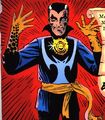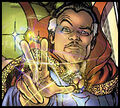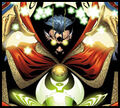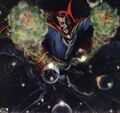|caption=
Doctor Strange as featured in Witches #1 (Aug. 2004). Art by Mike Deodato.

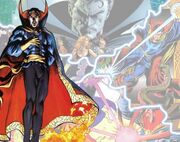
== Imformation ==
From Marvel Comics Wiki. |character_name=Doctor Strange |alter_ego=Doctor. Stephen Strange
|publisher=Marvel Comics
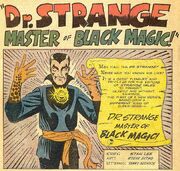
|debut=Strange Tales #110 (July 1963)
|creators=Stan Lee
Steve Ditko
|alliances=New Avengers
Illuminati
Defenders
Nightstalkers
Midnight Sons
|aliases=Stephen Sanders-created during a time when he felt he could use with true name.
|powers=Mastery of magic & extended life span
Genius level intellect
Neurosurgeon
Possesses the Soul Gem
|}}
== Introduction ==
A Profile on... Dr. Strange
by Les Daniels
Stephen Strange Dr. Strange is a part of the Marvel Universe, but he has always inhabited his own universe as well. "The Sorcerer Supreme of the Earth," a master of white magic, has experienced many memorable adventures in eerie dimensions that other heroes can only imagine. Yet if Dr. Strange has always been a bit aloof, his journeys into the unknown has served to expand the scope of the comic book landscape for every character who followed in his wake.
Introduced in 1963 by writer Stan Lee and artist Steve Ditko, Dr. Strange was very much a product of his time. The lure of mysticism was strong in the 1960s as a rebellious younger generation forged a counterculture that spurned materialism in favor of more spiritual values. Strange's affinity with bohemian attitudes was evident even in his address: he lived on Bleecker Street in New York's Greenwich Village. Originally a self-centered surgeon, Dr. Strange lost his delicate touch after an automobile accident, and became a wandering derelict. In the Himalayas he sought out a fabled healer called The Ancient One, who ended up repairing Strange's soul instead of his hands. Redeemed from worldliness, the reborn hero also tacitly acknowledged the value of a race and culture other than his own, studying with the old master until he was ready to become a guardian protecting humanity from the intrusion of evil. He encountered wicked wizards, and also abstract entities like Nightmare and Eternity; in each battle his weapon was knowledge rather than force.
Despite its influence, Dr. Strange's initial solo series did not outlast the 1960s. Yet he hung on in sporadic appearances for almost two decades until he was given his own comic book again in 1988. This full-fledged revival may have been tied in to the popularity of New Age occultism, or perhaps to a reaction against a decade devoted to acquisitiveness; in any case, spiritual longings are perennial. Even for those who sometimes find institutionalized religion repressive, a fascination with the supernatural remains.
A Doctor in the House
Dr. Strange's, an unusual hero who soon developed an enthusiastic cult following, achieved prominence by creeping up on it. Initially conceived as a one-shot in the back of Strange Tales #110 (July 1963), Dr. Strange's subsequently appeared and disappeared from the pages of the comic book that had given him his name. This seemed only proper since, after all, he was a magician. By 1964 his adventures had begun to show up on a regular basis, sharing the pages of Strange Tales with the Human Torch.
Strange Tales # 142 Inspired by the Mutual Network radio show 'Chandu the Magician', which Stan Lee had enjoyed during his childhood, Dr. Strange's was in fact a more impressive character that Chandu. Not content with simply casting spells or causing transformations, Dr. Strange's was ever journeying into weird worlds and uncanny dimensions; his environment was perhaps the most unusual in comic books. Steve Ditko's offbeat style was perfectly suited to the delineation of these nightmarish realms, and Dr. Strange's, the oddball magician, became the first Marvel hero other than Spider-man that Ditko handled on a regular basis.
"When you're looking at artwork that you think is magnificent, it's a privilege to put the words in," said Stan Lee about Ditko's drawing.
Ditko was never profilic, in part because he inked his own work instead of having it inkted by other artists as Jack Kirby did, yet his style had a dark power that made Dr. Strange's unique. Lee rose to the occasion with some of his most colorful dialogue, especially incantations like: "In the name of the dread Dormammu! By the hoary host of Hoggoth! I call upon the mystic realm!" Some gullible fans convinced themselves that Lee was a genuine student of arcane lore, but in fact he was making up nonsense syllables.
Taken from Marvel: Five fabulous decades of the world's greatest comics (c) Marvel Comics.
Les Daniels
Les Daniels
Les Daniels is the author of Comix: A History of Comic Books in America, which The New York Times called "scholarly and highly entertaining," and Living in Fear: A History of Horror in the Mass Media. His fiction, twice nominated for a World Fantasy Award, includes The Black Castle, The Silver Skull, Citizen Vampire, Yellow Fog and No Blood Spilled. He reviews films for The Boston Phoenix and lives in Providence, Rhode Island.
Marvel Comics
Beginning[]
Doctor Strange is a fictional character that appears in publications published by Marvel Comics. The character was co-created by writer Stan Lee and artist Steve Ditko and first appeared in Strange Tales #110 (July 1963).For some strange reason,that has never explained,the early Doctor Strange had a somewhat oriental appearence,as he was Asian or part asian.Marvel creators tend ignor this as it simply creative license by Steve Ditko and have mentioned this any interveiw or storyline.
Debuting in the Silver Age of comic books, the character has featured in several self-titled series and Marvel-endorsed products including arcade and video games; animated television series and a direct-to-DVD film and merchandise such as trading cards.Stan Lee and Steve Ditko's classic Strange Tales were crafted with a unique blend of wonder, mystery, reverence, and lurking peril. Ditko's inventive, inviting, extra-dimensional artwork set the standard for all Strange artists to come. The Lee/Ditko team lasted until #146, followed by tales from scripters Denny O'Neil and Roy Thomas, with artwork by Bill Everett, Marie Severin, and Dan Adkins.
Strange Tales introduced such key characters as the Ancient One, Wong, Clea, and Baron Mordo, and such nefarious foes as Nightmare, Dormammu, Ummar, Eternity, and the Living Tribunal.
The good Doctor shared the Strange Tales title with various other series, primarily the Human Torch and Nick Fury. Finally, he received his own title starting with #169, which continued the numbering from the Strange Tales title.
'Doctor Strange (Stephen Strange)'
(Redirected from Doctor Strange)
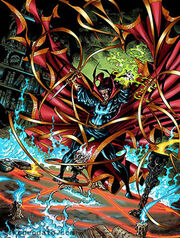
Universe Marvel Universe
Real Name Stephen Vincent Strange

Aliases Sorcerer Supreme, Master of the Mystic Arts, Stephen Sanders, Captain Universe, Vincent Stevens, Strange
Identity The general public regards Strange as an ordinary occult scholar, if not a charlatan
Citizenship U.S.A.
Place of Birth Philadelphia, Pennsylvania
First Appearance Strange Tales #110 (1963)
Origin Strange Tales #115 (1963); Doctor Strange #169 (1968); Doctor Strange #45 (1992) Significant Issues Left the Avengers (New Avengers Annual #2, 2008) Occupation Sorcerer Supreme of Earth dimension, occult consultant; formerly physician, neurosurgeon Known Relatives Eugene Strange (father, deceased), Beverly Strange (mother, deceased), Victor Strange (Khiron, brother, apparently deceased), Donna Strange (sister, deceased), Clea (wife, estranged), Umar (mother-in-law), Orini (father-in-law), Dormammu (uncle-in-law) Group Affiliation Formerly Avengers, the Order, Defenders, Midnight Sons; former disciple of the Ancient One Education Medical doctorate; extensive sorcery training Physical Attributes
Height 6'2 1/2"
Weight 180 lbs.
Eyes Gray
Hair Black, white at temples-when he wasn't some silly mask to hide his true face for dummest of reasons.
Powers[]
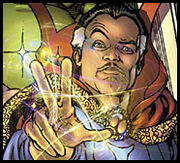
Doctor Strange is one of the most powerful sorcerers in existence. Like most sorcerers, he draws his power from three primary sources: the invocation of powerful mystic entities or objects, the manipulation of the universe's ambient magical energy, and his own psychic resources. Strange's magical repertoire includes energy projection and manipulation, matter transformation, animation of inanimate objects, teleportation, illusion-casting, mesmerism, thought projection, astral projection, dimensional travel, time travel and mental possession, to name a few. The full range of his abilities is unknown. Doctor Strange's powers are sometimes less effective against strictly science-based opponents, although he can overcome this limitation with effort.
Abilities[]
Doctor Strange is a skilled athlete and martial artist with substantial medical and magical knowledge. Though an expert surgeon, Strange's nerve-damaged hands prevent him from performing surgery except when supplemented by magic. Weapons None
Paraphernalia[]
Doctor Strange wears the Eye of Agamotto, an amulet which can radiate light, pierce illusions, probe minds, open extradimensional portals, and perform other feats. He has a Cloak of Levitation which enables him to fly without expending personal magical energy. He possesses several other mystic artifacts, including the Orb of Agamotto, which he can use to observe events virtually anywhere in the multiverse. He has a library of mystic tomes, some of which, such as the Book of the Vishanti and the Darkhold, can serve as power sources or weapons in their own right. Born in 1930, Stephen Strange was the eldest child of Eugene and Beverly Strange, then vacationing in Philadelphia. Two years later, Stephen's sister Donna was born at the family's Nebraska farm. At age eight, Strange was beset by demons controlled by apprentice sorcerer Karl Mordo, but was rescued by Mordo's mentor, the Ancient One, a millennia-old sorcerer who protected the Earth dimension as its Sorcerer Supreme, a role Strange was destined to inherit. At age eleven, a year or two after his brother Victor's birth, Strange aided an injured Donna, the experience inspiring him to pursue a medical career.
After high school, Strange entered pre-med at a New York college. Later, home on vacation for his nineteenth birthday, Strange went swimming with Donna, who suffered a cramp and drowned. Finding her body after a desperate search, Strange felt a sense of personal failure that eroded his medical idealism. After earning his medical degree in record time, he entered a five-year residency at New York Hospital, where his rapid success made him arrogant. When his mother Beverly died near the end of his residency, a bereaved Strange grew distant from his work. His talent was unaffected, though, and he became a wealthy, celebrated neurosurgeon before he turned thirty. His egotism made him cold and callous, interested only in high fees. He saved the life of injured United Nations translator, Madeleine Revell; following a romance and proposal, she left him due to his increasingly materialist nature. Two years after Beverly's death, her husband Eugene fell ill; unable to face another family death, Stephen refused to visit his deathbed. A few days later, an outraged Victor berated Stephen for his apparent lack of grief, then rushed from Strange's apartment into the path of an oncoming car. Blaming himself, Strange placed Victor's body in cold storage, half-hoping that future breakthroughs could revive him.
Circa 1963, Strange was in a car accident that severely damaged the nerves in his hands, ending his surgical career. Too vain to accept positions as a consultant or assistant, Strange sought a cure and pursued every available treatment, legitimate or not, soon depleting his fortune; in months he was reduced to a derelict, performing shady medical procedures that barely paid his bar tabs. After hearing rumors of the mystical Ancient One, a desperate Strange pawned his last possessions for a ticket to the East and found the Ancient One's Tibetan palace. At first annoyed when the Ancient One refused to cure him, Strange was later astonished to see the sorcerer attacked by mystic forces.
Upon learning that the Ancient One was Earth's magical defender and that the attack on him came from his pupil Mordo, Strange tried to warn him, but Mordo mystically prevented Strange from doing so. For the sake of the Ancient One and the world, Strange acted unselfishly for the first time in years, vowing to learn magic himself so he could counter Mordo and his ilk. He offered himself as a disciple to the Ancient One, who accepted, having known of Mordo's treachery all along. The Ancient One spent years instructing Strange in the art of sorcery, teaching him how to tap the innate mystic powers of both himself and the world around him, as well as how to invoke the power of awesome entities, or Principalities, who resided in their own realms, most notably the three benign beings known as the Vishanti. A few years after Strange's arrival, Mordo left to seek greater power, and would often clash with Strange in the future. Strange's guilt over his earlier mistakes weighed heavily upon him over the years, and not all of his early recollections can be trusted.
During his years of study and early activity, Strange befriended many sorcerers around the world, including Lord Julian Phyffe and Sir Clive Bentley of Great Britain; Cardinal Alfeo Spinosa and Count Carezzi of Italy; Omar Karindu, Rama Kaliph, and Turhan Barim of the Middle East; Wai Chee Yee and Sen-Yu of Asia; and Aleister Kane, Kenneth Ward, and Frank Brukner of America. Other immortal adventurers, such as Immortalis and Terror, Inc., regarded his ascent with skepticism. Strange also found allies among more earthly heroes, aiding the adventurer Black Fox in at least two adventures. No later than the 1970s, Strange returned to America, becoming a mystic consultant in New York's Greenwich Village. He was joined by Wong, the descendant of a line that had served the Ancient One for centuries, who became his servant and friend. Strange's earliest foes included the demonic Bottle Imp; a nightmarish manifestation of the entity KhLΘg; and the demon Nightmare, who preyed upon humanity's dreams and became one of Strange's bitterest enemies. Developing a mysterious reputation like the Ancient One before him, Strange became an occasional consultant to local and even federal authorities.
While the Fantastic Four's debut heralded an upsurge of superhuman activity in recent years, Strange remained aloof from New York's many super heroes at first. The powerful Asgardian god Loki later tricked Strange into covertly attacking Loki's heroic foster brother, Thor; however, Strange soon pierced the deception and united with Thor to drive off Loki. Soon afterward, a clash with Mordo led Strange to encounter the young Spider-Man, who helped Strange rescue several people from a mystic dimension and convinced him to remove their memory of the traumatic experience, even though this caused them to forget Spider-Man's heroism as well. Impressed by Spider-Man's bravery and altruism, Strange came to regard him as a friend, and the two unlikely allies have teamed up many times over the years.
Strange soon faced the Dreaded Dormammu, ruler of the Dark Dimension and one of the Ancient One's oldest foes. Sensing the Ancient One's declining power, Dormammu plotted anew to invade the Earth dimension and challenged Strange to a mystic duel in the Dark Dimension. While there, Strange was approached by Clea, a novice mystic and daughter of Dormammu's sister Umar, although few knew her parentage at the time. Clea sought to prevent the duel, fearful that her home dimension would be devastated by the Mindless Ones if its ruler fell, but Strange would not yield. Although Dormammu vastly out powered Strange, their duel drained his energies enough to weaken the barrier which contained the Mindless Ones. Strange, unwilling to endanger the Dark Dimension's denizens, lent Dormammu enough power to restore the barrier. Enraged by his own weakness, Dormammu felt honor-bound to spare Strange, who bargained with him to spare both the Earth dimension and Clea, whom he found very attractive; however, Dormammu swore vengeance and became one of Strange's most implacable enemies.
Stan Lee and Steve Ditko's classic Strange Tales were crafted with a unique blend of wonder, mystery, reverence, and lurking peril. Ditko's inventive, inviting, extra-dimensional artwork set the standard for all Strange artists to come. The Lee/Ditko team lasted until #146, followed by tales from scripters Denny O'Neil and Roy Thomas, with artwork by Bill Everett, Marie Severin, and Dan Adkins.
Strange Tales introduced such key characters as the Ancient One, Wong, Clea, and Baron Mordo, and such nefarious foes as Nightmare, Dormammu, Ummar, Eternity, and the Living Tribunal.
The good Doctor shared the Strange Tales title with various other series, primarily the Human Torch and Nick Fury. Finally, he received his own title starting with #169, which continued the numbering from the Strange Tales title.
Shortly after this, Strange openly joined several super heroes in battling the powerful mutate Sundown. He became a special consultant to prominent super-teams like the Fantastic Four, the X-Men and the Avengers. Months after attending the wedding of Reed and Sue Richards, Strange was reunited with Clea, who returned his love and came to live with him in New York.
'== The Origin of Dr. Strange. =='
The Coming of... Dr. Strange
Dr. Strange #169
6/68
Stephen Strange seeks out the Ancient One in the Himalayas in hope of a cure for the damaged nerves in his hands. He discovers that Mordo, a pupil of the Ancient One, is plotting to kill the old master. Strange tries to warn the Ancient One, but the Ancient One is wise to Mordo's scheme and stops the evil mage. Strange decides to stay with the Ancient One to become his pupil in the mystic arts.Obviously a retelling of Doctor Stranges origins,since the origin tale and character existed prior to this issue.
A battle against Nightmare within the mind of the Ancient One.
==the New Doctor Strange==
Synopsis
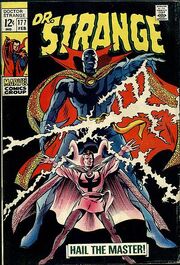
The Cult and the Curse
Asmodeus assumes the form of Dr. Strange, to fool Ancient One. Later, following an extradimensional ordeal, he was forced to change his appearance in order to cross the barrier to Earth; he altered his traditional attire and added a full-face mask, perhaps in imitation of his super-hero allies. Upon his return, Strange retained this appearance to preserve his anonymity but later carelessly revealed his real name to a crowd while fighting Nightmare.Strange takes on new masked costume.And why other than recreate Doctor Stranges appearence,because low sales was the reason this was done,otherwise it made little sense with character as powerful as having alter his appearence because some low rate villian at the time did to him. Doctor Strange could simply undid anything Asmodeus did to impersonate him and went being Doctor Strange-Sorcerer Supreme.Some fans have critisized and rightfully so,that this Dr.Strange looked to much like Golden Age Vision or The Silver Surfer.Either way,it was a poor editorial descision and failed interest comic fans in New Doctor Strange.Maybe it might have work if it a Doctor Strange from another world or universe,taking his role on Earth for a time,but it was just too radical,once you get used to the way he's drawn since issue one.These radical attempts to alter a comic character never,ever or rarely work,but stupid editors keep on doing despite past failures as they might have formula for success when all other found out that those changes never or rarely work with major characters. Asmodeus recites the Spell of Fire and Ice with dying breath, releasing Ymir the frost giant and Surtur the fire demon. Eternity, the universal embodiment whom Strange was aiding at the time, altered all documents and memories on Earth, changing the name of "Stephen Strange" to "Stephen Sanders" to allow Strange a private persona once more.Writer Roy Thomas and artist Gene Colan created their own "classic" version of Dr. Strange, characterized by Colan's fluid photo-surreal artwork. The series hit a low, however, when Dr. Strange was given superhero tights and a mask!All hail the Master.There are many forms and appearences of Doctor Strange,but few could and still don't accept this form or appearences.Most fans just felt it was too radical-too despirate an attempt to salvage a dying publication. The title was cancelled shortly thereafter and blue faced Masked Doctor Srange and Stephan Sander idenity did last much longer afterwards. Strange next faced the Undying Ones, a vastly powerful demon race led by the Nameless One, who had once dominated Earth. During these struggles, Strange manipulated Namor the Sub-Mariner and the monstrous Hulk into aiding him. With the Undying Ones defeated, Strange seemingly believed that the Earth dimension was sealed from mystic incursion, and, troubled by his arrogant exploitation of Namor and Hulk, he abandoned his mystic duties and became a medical consultant, performing the selfless duties he had once thought beneath him.Obviously the character was going into retirement until he returns with the pages The Defenders
Weeks later, Strange returned to action when Baron Mordo tried to kill him. Aided by the Ancient One, Strange reclaimed his sorcerer role and defeated Mordo, while the Ancient One, for reasons of his own, reversed Eternity's spell, restoring the name "Stephen Strange" to the world's records and memories. When the Nameless One returned shortly thereafter, Strange resumed his non-masked attire and again recruited Namor and the Hulk to fight alongside him. The three heroes later fought other threats and were soon joined by the alien Silver Surfer. This quartet formed the core of the heroic Defenders team, becoming friends despite their differences.
Strange soon clashed with powerful demon servants of Shuma-Gorath, a vast extradimensional entity who had menaced Earth thousands of years ago and now sought to return via the mind of the Ancient One himself. At his mentor's prompting, Strange slew the Ancient One, preventing Shuma-Gorath's passage. The Ancient One's physical death made him one with Eternity, and Strange became Sorcerer Supreme, guardian of the entire universe. Heavily burdened by his new responsibilities and seeking the solace of family, Strange tried and failed to revive his brother Victor using spells from the Book of the Vishanti, not realizing he was reading the Vampiric Verses, imbuing Victor with the potential for resurrection as a vampire.
Strange continued to share adventures with the Defenders, and over the months the informal team's ranks expanded to include the Asgardian Valkyrie, the winged millionaire Nighthawk, the happy-go-lucky Hellcat, and others. Strange's time with the team forced him to face more non-mystical foes, such as the mutant Magneto, the alien Nebulon the Celestial Man, the subversive Sons of the Serpent and the bizarre masterminds called the Headmen. Strange's sanctuary often served as Defenders headquarters, and their camaraderie, plus the love of Clea, gave Strange a welcome change from his customary solitude.
Manipulated by the trans-temporal sorcerers called the Creators, the Ancient One's spirit offered Strange a chance to become one with the universe, but Strange refused and was stripped of the title and power of Sorcerer Supreme. Shortly afterward, Strange battled the Creators, thwarting their reality-reshaping plans by defeating their ally, the cosmic In-Betweener. With their deception revealed, the Ancient One restored Strange's former status. Although Strange's adventure took mere days from his perspective, weeks apparently passed on Earth; who, if anyone, held the post of Sorcerer Supreme during these weeks is unrevealed.
Months later, Strange and the three other senior Defenders parted ways after a cosmic hoax by the mysterious alien Tribunals convinced them their alliance was destined to cause cosmic tragedy. Next allied with a band of vampires hunters against Dracula, Strange cast the Montesi Formula spell taken from the ancient magic tome the Darkhold. This spell destroyed virtually all vampires within the Earth dimension; however, unknown to Strange, the spell's energy washed over the forgotten Victor Strange, where its power combined unpredictably with Strange's earlier spell.
Meanwhile, Clea had returned to the Dark Dimension to lead the rebellion against its current ruler, Umar, whom she soon learned was her mother. Strange helped Clea ascend to her home universe's throne, but, bound by their respective responsibilities, the couple regretfully separated. Strange next found those very responsibilities challenged by the evil extraterrestrial Urthona, who coveted the role of Sorcerer Supreme. A desperate Strange destroyed his own collection of mystic artifacts and tomes to deny Urthona their power; unknown to Strange, his collection was in fact rescued by Agamotto, one of three Principalities who formed the Vishanti.
With the removal of Strange's artifacts, various occult threats that had been repelled by their power over the millennia broke free, leaving Strange to face them with reduced power. Accompanied by the extradimensional novice mystic Rintrah, Strange encountered the Ancient One's old rival Kaluu, who offered to teach him life-draining black magic as a defense against the returning forces; Strange reluctantly accepted. Strange's black magic ventures culminated in a rematch with Shuma-Gorath, which ended with the demon seemingly destroyed and Strange little better-off, but Strange eventually recovered and returned home. Shortly thereafter, he visited the Dark Dimension and married Clea, who came to live with him on Earth, ruling her kingdom from afar. Strange took Rintrah as his new apprentice, and a surreal encounter with Agamotto restored his seemingly lost artifacts and tomes.
Strange faced a far more unexpected part of his past when his brother Victor revived as the first of a new breed of vampire. Victor fell under the sway of sorceress Marie LaVeau, who sought to blackmail Strange into reciting the Vampiric Verses, nullifying the effects of the Montesi Formula. Strange instead banished the Vampiric Verses page from the Earth dimension, but Marie LaVeau used Victor as a template to duplicate the spell, making it possible for long-destroyed vampires to reappear. Unable to undo this threat, Strange and Clea were next drawn into a war between Dormammu and Umar for rule of the Dark Dimension; ultimately Umar reclaimed the throne, leaving Clea in exile with Strange. Strange next allied himself with several super heroes against the mad Titan Thanos, who used the near-omnipotent Infinity Gauntlet to eradicate half of the universe's population before Earth's heroes defeated him and reversed the effect.
As Clea sought allies to regain the Dark Dimension, Strange formed alliances of his own by manipulating the formation of the Midnight Sons, a loose-knit group of supernatural heroes, including those who had helped him invoke the Montesi Formula, destined to confront ancient evils. During Clea's absence, he briefly tutored the young sorcerer Augustyne Phyffe, who ultimately chose to abandon sorcery. After sharing leadership of Earth's heroes against the Magus during the Infinity War, Strange teamed with Namor, the Hulk, and the Silver Surfer to battle Shanzar, the invading Sorcerer Supreme of another dimension (by now, Strange had long since discovered the Tribunals' hoax and knew it was safe for the senior Defenders to reunite).
Meanwhile, the Principalities of various mystic realms faced the War of the Seven Spheres, a cataclysmic clash with opposing entities that was expected to last five thousand years. Several of them, including the Vishanti, attempted to enlist allies such as Strange, but Strange refused to abandon his earthly duties and, being no match for the godlike Principalities, renounced the use of their mystic energies. Thus stripped of much of his power, Strange was ill-prepared to face a vastly enhanced Dormammu, who had manipulated Clea's deposal of Umar so that he could again rule the Dark Dimension. Strange recruited the Hulk, the Silver Surfer, and the Ghost Rider (Dan Ketch) to aid him in repelling Dormammu, who retained control of the Dark Dimension despite Strange's victory, and Clea remained there to lead the new resistance. Strange sought out Immortalis in hopes of curing Victor, but was refused due to the temporary nature of the cure. Shortly afterward, Rintrah was seemingly slain destroying a dangerous talisman, and Strange, after placing Rintrah's body in stasis pending potential revival, took as a new apprentice Kyllian Kell, a youth empowered by Celtic Gods. Strange also began periodically gathering informal teams of heroes as "Secret Defenders" to face threats he could not handle alone. Strange was among the heroes mesmerized by the Goddess, who sought to remake the universe through her Infinity Crusade. While Strange's physical form served the Goddess, his astral form investigated the actions of Victor Strange, now the costumed hero Khiron, who had become too deadly a vigilante for Strange's liking. Realizing how violent he had become, Khiron took his own life, but Strange had little time to mourn; shortly after breaking free of the Goddess, Strange again faced Urthona, who had enlisted in the War of the Seven Spheres and had thus gained as much power as Strange had lost. Surviving this encounter, Strange tried to rescue Kyllian from a mystic dimension but left him behind when called to join the Midnight Sons against the ancient sorceress Lilith; weeks later, Kyllian returned in the enhanced form of Wildpride, later fighting both Strange and the Midnight Sons. Joining an international coalition of heroes in opposing the techno-magical threat of Mys-Tech's Un-Earth, Strange was one of six beings who stabilized the resulting unraveled reality.
Strange's life was further complicated by Salomé, a winged member of the mysterious Blood race and allegedly the first Earth-born Sorcerer Supreme over 20,000 years ago. With Strange's power still low, Salomé easily reclaimed her title; however, she cared little for humanity and began gathering followers to help her rule the Earth. Desperate for more power, Strange secluded himself in a pocket dimension, from which he dispatched two magical constructs based upon himself: Vincent Stevens, who built a fortune with which to develop so-called technomagick, and a being called Strange, who fought alongside the Midnight Sons and gathered objects of mystic power throughout the world. Unable to spare the energy to lead the Secret Defenders, Dr. Strange abruptly forced this responsibility upon another former student of the Ancient One, Doctor Druid, who served as best he could yet was ultimately unable to maintain the operation.
Dr. Strange had barely finished enhancing his sorcery when Stevens and Strange rebelled against him; in the resulting clash, Stevens was apparently destroyed, and Strange went to the Dark Dimension, where he merged with the rebellion's Nobel as Paradox, working beside Clea. Using elemental magic to defeat Salomé, Dr. Strange assumed a short-lived younger form and briefly adopted a more violent persona to shut down illegal operations engineered by Stevens. However, Dr. Strange's plans were interrupted when the Vishanti once again demanded his service in the War of the Seven Spheres. Unwilling to risk yet another loss of power, Strange complied.
Although Strange spent five thousand years fighting for the Vishanti against the mysterious Trinity of Ashes, he returned to Earth with little sign of physical age, only a few months after he had departed, his memories of the war largely suppressed; again, it is not known if anyone carried out Strange's duties in his absence. Having exhausted his typical powers, Strange sought new ones through the use of unpredictable Catastrophe Magic, which he later supplemented with so-called Chaos Magic; however, Strange later claimed there was no such thing as Chaos Magic, confusing matters considerably. In any event, Strange eventually regained the patronage of the Principalities, his powers restored to their height. Dormammu used the mutant Jonathon White and Strange's ally Topaz against the mage, but Strange drove off his enemy and magically guided another surgeon to save Topaz from Dormammu's attack.
Another sort of status quo returned when the extradimensional techno-mage Yandroth, an old foe of both Strange and the Defenders, unleashed destructive forces upon the Earth. Strange, Namor, Hulk and the Surfer united against Yandroth, but time had made them less compatible. When Yandroth seemingly perished, he used Earth's magical energy to bind the quarrelsome quartet with a spiteful curse that would force them together against all future threats to Earth, regardless of their other concerns. Other Defenders alumni lent their aid in coping with this situation, and Strange, although irritated by Yandroth's curse, was not untouched by the renewed camaraderie of his fellow heroes. However, the curse magnified the anger and egos of the four senior Defenders until they became mentally unstable and, as the Order, sought to end all threats to the Earth by taking control of it. Several other heroes, including Clea, fought them, and the energies unleashed by the battle were harnessed to resurrect Yandroth in a powerful new form. Shocked back to their senses by this development, the four Defenders stopped fighting, which reduced Yandroth to human form. Yandroth was defeated and imprisoned.
Shaken by his misuse of power and position, Strange cut himself off from his super-hero allies, even becoming aloof from his longtime friend Spider-Man. When the idealistic mystic Topaz became Strange's fifth known disciple, he held her at an emotional distance and, when she disobeyed him in the aftermath of a mystic threat, he dismissed her. Although Strange continues to defend the Earth dimension and to assist fellow heroes as needed, his old arrogance has resurfaced, and his ultimate role in recent upheavals within the superhuman community remains to be seen. For other people known as Doctor Strange, see Doctor Strange (disambiguation).
Publication history[]
1960s[]
The character debuted in Strange Tales #110 (July 1963), a "split book" shared with fellow Marvel character the Human Torch until issue #134 (July 1965), and then super spy Nick Fury until issue #168 (May 1968). Strange appeared in #111 and #114 before the character's eight page origin story appeared in #115 (Dec. 1963).
Ditko drew the feature through Strange Tales #146 (July 1966), and during this period he and Lee introduced many of Strange's allies, such as his eventual lover Clea, who debuted, (although was not initially named) in Strange Tales #126 (Nov. 1964)' and enemies such as Nightmare, in #110, and the flame-headed Dormammu, in #126 (Nov. 1964). "Doctor Strange" stories showcased surrealistic mystical landscapes and increasingly head-trippy visuals that helped make the feature a favorite of college students. "People who read 'Doctor Strange' thought people at Marvel must be heads [e.g. drug users]," recalled then-associate editor and former Doctor Strange writer Roy Thomas in 1971, "because they had had similar experiences high on mushrooms. But ... I don't use hallucinogens, nor do I think any artists do."[1]
Eventually, as co-plotter and later sole plotter, in the "Marvel Method", Ditko would take Strange into ever-more-abstract realms. In an epic 17-issue story arc in Strange Tales #130-146 (July 1965 - July 1966), Ditko introduced the cosmic character Eternity, who personified the universe and was depicted as a silhouette whose outlines are filled with the cosmos.[2] As historian Bradford W. Wright describes,
"Steve Ditko contributed some of his most surrealistic work to the comic book and gave it a disorienting, hallucinogenic quality. Dr. Strange's adventures take place in bizarre worlds and twisting dimensions that resembled Salvador Dali paintings. ... Inspired by the pulp-fiction magicians of Stan Lee's childhood as well as by contemporary Beat culture. Dr. Strange remarkably predicted the youth counterculture's fascination with Eastern mysticism and psychedelia. Never among Marvel's more popular or accessible characters, Dr. Strange still found a niche among an audience seeking a challenging alternative to more conventional superhero fare."[3]
From the beginning, stories revealed that Dr. Strange uses magical artifacts to augment his power, such as the Cloak of Levitation;[4] the Eye of Agamotto in #115 (Dec. 1963); the Book of the Vishanti in #116 (Jan. 1964); and the Orb of Agamotto in #118 (March 1964). From the first story, Strange's residence, the Sanctum Sanctorum, was a part of the character's mythos. The trademark circular window divided by three sweeping lines on the front of the residence (actually the protective Seal of the Vishanti) appeared in many Doctor Strange stories. Strange's personal servant, Wong, guarded the residence in his absence.[5]
Splash page for the Doctor Strange story in Strange Tales #110 (July 1963). Art by Steve Ditko.
In keeping with Lee's emphasis on continuity, Strange was also quickly established as part of the Marvel Universe, and guest starred in Fantastic Four #27 (June 1964), encountered the Norse god Loki, foster brother of Thor, in Strange Tales #123 (Aug. 1964), and guest-starred with Ditko's other major Marvel co-creation in The Amazing Spider-Man Annual #2 (1965).</ref>
The series continued with Lee dialoging Ditko's plots through Strange Tales #142, followed by Roy Thomas (two issues) and Denny O'Neil (two issues). Ditko's last issue was Strange Tales #146, with Golden Age great Bill Everett succeeding Ditko as artist until #152, followed by Marie Severin through #160 and Dan Adkins through #168,[6] the final issue before the "Nick Fury" feature moved to its own title and Strange Tales became Doctor Strange.
Lee had returned to write the character in Strange Tales #151-157; followed by Thomas (#158-159), and two writers who did virtually no other Marvel work, Raymond Marais (#160-161) and Jim Lawrence (#162-166). The post-Ditko Strange Tales stories introduced another cosmic entity, the Living Tribunal, in #157 (June 1967) and the evil Umar, sister of Dormammu, in #150 (Nov. 1966) The title, however, was flagging, with Strange encountering such one-off foes such as Nebulos and Voltorg in Strange Tales #162 and #166, respectively.
The now 20-page solo series Doctor Strange ran 15 issues, #169-183 (June 1968 - Nov. 1969), continuing the numbering of Strange Tales. Thomas wrote the run of new stories (Strange Tales #179 being a reprint), joined after the first three issues by the art team of penciler Gene Colan and inker Tom Palmer through the end. Thomas and Colan attempted to boost sales by revamping Strange and making the character closer to being a superhero. Given a form-fitting blue costume, a full-head mask and a secret identity as Dr. Stephen Sanders, the character teamed with the superheroes the Black Knight[7] and Spider-Man,[8] and battled the X-Men foe the Juggernaut.[9] The changes were unsuccessful and the title was canceled with issue #183 (Nov. 1969). The cancellation was abrupt (there was a "Next Issue" blurb in the last issue), and outstanding storylines were resolved in Sub-Mariner #22 (Feb. 1970) and The Incredible Hulk vol. 2, #126 (April 1970).
Thomas recalled in 2000 that he eloped in July 1968 to marry his first wife, Jean, and returned to work a day late from a weekend comic-book convention to find that Marvel production manager Sol Brodsky had assigned Doctor Strange to writer Archie Goodwin, newly ensconced at Marvel and writing Iron Man. Thomas convinced Brodsky to allow him to continue writing the title. "I got very possessive about Doctor Strange," Thomas recalled. "It wasn't a huge seller, but [by the time it was canceled], we were selling the low 40 percent range of more than 400,000 print run, so it was actually selling a couple hundred thousand copies [but] at the time you needed to sell even more."[10]
1970s[]
Strange's next appearance was in the first three issues of the showcase title Marvel Feature, appearing in both the main storyline detailing the formation of superhero "non-team" the Defenders, and the related back-up story.[11] The character was showcased in the title Marvel Premiere[12] with one story marking the debut of another of Strange's recurring foes, the entity Shuma-Gorath. To stop Shuma-Gorath entering reality, Strange is forced to shut down the Ancient One's mind, which causes his physical death. The Ancient One, however, assures Strange this was a necessary sacrifice and his soul merges with the cosmic entity Eternity. Strange then assumes the title of Sorcerer Supreme.[13]
1980s - 1990s[]
The character's adventures continued in a second ongoing series, Doctor Strange: Master of the Mystic Arts, which ran for 81 issues (June 1974 - Feb. 1987). During this period Strange also meets allies Topaz[14] and Rintrah.[15] Following the title's cancellation, the character's adventures continued in a second volume of Strange Tales, which was again published in the "split book" format, and shared with street heroes Cloak and Dagger. The title ran for nineteen issues.[16]
Strange again featured in another self-titled series; Doctor Strange: Sorcerer Supreme. The initial creative team was writer Peter B. Gillis and artists Richard Case & Randy Emberlin, with storylines often written as multi-issue arcs. Strange was written as being on the defensive from the first issue, battling a host of supernatural foes including Dormammu,[17] demons Mephisto and Satannish[18] and encounters with the Werewolf By Night;[19] Ghost Rider;[20] Baron Blood[21] and Morbius the Living Vampire.[22] One significant development was Strange's temporary loss of the title of "Sorcerer Supreme" when he refused to fight a war on behalf of the Vishanti, mystical entities that empowered Strange's spells.[23] Despite this and other setbacks, Strange was triumphant and eventually restored to the title.[24] The series ran for 90 issues (Nov. 1988-June 1996).
Strange appeared - together with original regulars the Human Torch and the Thing - in a one-shot publication called Strange Tales.[25]
The character features in several limited series, the first being Doctor Strange: The Flight of Bones, with a series of spontaneous combustions by criminals instigated by old foe Dormammu.[26] Strange was the catalyst for the creation of a trio of witches in the self-titled Witchesmini-series [27] and also appeared in the self-titled Strange mini-series, written by J. Michael Straczynski and Samm Barnes, with artwork by Brandon Peterson. The series reimagined the character's origin, allies and enemies in a contemporary setting.[28] A second limited series, Doctor Strange: The Oath, written by Brian K Vaughan and illustrated by Marcos Martin, focused on Strange's duty as Sorcerer Supreme and the nature of his powers.[29]
Doctor Strange also appeared in four graphic novels.[30]
The character has remained a constant in the Marvel Universe over the decades, appearing on a regular basis in three volumes of the title Defenders;[31] Secret Defenders[32] and a limited series focused on the Defenders titled The Order.[33] Strange also featured in all three volumes of the title Marvel Team-Up[34] and other one-off stories in titles Marvel Two-In-One;[35] Marvel Fanfare[36] and the alternate universe title What If.[37] The character also featured in the first issue of the title Nightstalkers, forming a team of anti-heroes in preparation for the return of vampires to the Marvel Universe.[38]
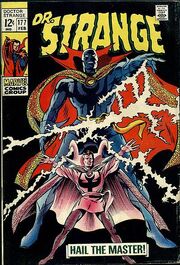
Doctor Strange #177 (Feb. 1969): the debut of Strange's short-lived new look. Cover art by Gene Colan and Tom Palmer.
2000s[]
Strange appears as a supporting character in pivotal stories in 2000s. In New Avengers #7 (July 2005), writer Brian Michael Bendis retconned Marvel history and established that during the Kree-Skrull War,[39] several metahumans, including Strange, formed a secret council called the Illuminati to deal with future threats to Earth.
Strange played a pivotal role at the conclusion of the House of M miniseries, as courtesy of his magic several of the mutant X-Men were able to retain their powers when reality was rewritten.[40] The "Civil War" storyline — involving the introduction of the Superhuman Registration Act and a split in the superhero community — found Strange opposed to mandatory registration. He leaves the Illuminati and goes into seclusion in the Arctic until the issue is resolved.[41]
The New Avengers: Illuminati miniseries revealed that Strange and the Illuminati took proactive steps to avoid global threats by finding and isolating the Infinity Gems, with Strange taking possession of the Soul Gem (a condition being that the individuals hide the Gems and never reveal their location to other members).[42] When Strange returns from the Arctic he secretly shelters the team the New Avengers, formed after the events of the Civil War, in his residence and assists on several missions.[43] Strange suffered a setback when his hands were broken during the events of the "World War Hulk" storyline, and he resorted to the use of dark magic to try and stop the Hulk.[44]
Strange's use of dark magic becomes addictive, as he uses it again to repel an attack on his residence by the crime syndicate of the villain Hood (who is in turn backed by Strange's foe Dormammu).[45] After some reflection, Strange seeks out a successor Sorcerer Supreme, and considers several magic-users such as Wiccan, the Scarlet Witch, Magik, and Doctor Doom, while Dormammu attacks Earth in a bid to seize Strange's power. The Avengers aid Strange against Dormammu's minions, with the Eye of Agamotto choosing Brother Voodoo as Strange's successor.[46]
Fictional biography[]
Stephen Strange is a world-renowned but selfish neurosurgeon, until a car accident damaged his hands, preventing him from conducting surgery. Depressed and scouring the world for a cure to his condition, Strange locates a hermit called the Ancient One in the Himalayas. After Strange selflessly attempts to thwart the Ancient One's traitorous disciple, Baron Mordo (who would become one of Stange's most enduring antagonists), he is taught the mystic arts.[47]
As the Ancient One's disciple, Strange encounters the entity Nightmare[48] and a number of odd mystical foes[49] before battling his eventual arch-foe: Dormammu, a warlord from a alternate dimension called the "Dark Dimension". Strange is also aided by a nameless girl, who is eventually revealed to be the niece of the villain and called Clea. When Strange helps a weakened Dormammu drive off the ramapaging beasts the Mindless Ones and return them to their prison, he is allowed to leave unchallenged.[50]
Powers and abilities[]
Doctor Strange is a master magician, and was the holder of the title of "Sorcerer Supreme" of the Marvel Universe for many years.[51] Eternity, the sentience of the Marvel Universe, has described Strange as "more powerful by far than any of your fellow humanoids".[52]
The character can use magic to achieve a number of effects, such as energy projection;[53] teleportation;[54] telepathy;[55] astral projection[56] the creation of materials, such as food[57] and water,[58] or creating planet-wide protective shields.[59] When casting a spell the character is often written to be invoking the name of a mystical entity, such as one of the Vishanti (Hoggoth, Oshtur and Agamotto) or the group the Octessence. These entities usually lend their power to a particular effect, such as the Crimson Bands of Cyttorak, that Strange can use to entrap foes.[60]
Strange was also schooled in the use of dark magic by one-time foe Kaluu, using it to destroy the entity Shuma-Gorath. The use of this magic, however, is both addictive and corruptive and Kaluu had to purge the magic from Strange before it could take full effect.[61]
Other versions[]
- Main article: Alternate versions of Doctor Strange
Two months before the debut of the sorcerer-hero Doctor Strange, Stan Lee (editor and story-plotter), Robert Bernstein (scripter, under the pseudonym "R. Berns") and Jack Kirby (artist) introduced a criminal scientist and Ph.D. with the same surname (called "Carl Strange"). Making hi</nowiki>s sole appearance as an early Iron Man foe, in the Tales of Suspense story, "The Stronghold of Dr. Strange", the character gained mental powers in a freak lightning strike.[62]
The character stars in several alternate universe titles: in the limited series Marvel 1602, Sir Stephen Strange is both the court physician and magician to Queen Elizabeth I.[63] The title Spider-Man 2099 introduces a female version of Strange who shares her body with a demon.[64] In the limited series Marvel Zombies Strange is infected with a zombie virus with many other heroes;[65] and reappears in the third installment in the series, Marvel Zombies 3. After being zombified, Strange is only capable of casting two spells.[66]
In the Marvel imprint MC2, an alternate universe future, Dr. Strange is no longer the Sorcerer Supreme, the title being passed to "Doc Magnus". Dr. Strange uses his remaining power to reform the superhero team the Defenders,[67] and to fight the Norse god of mischief, Loki.[68]
The Ultimate Marvel title Ultimate Marvel Team-Up introduces a version of the character called "Stephen Strange Jr.", the son of the original Doctor Strange.[69] The character is eventually killed in battle by the Ultimate version of Dormammu during the Ultimatum storyline.[70]
In other media[]
- Main article: Doctor Strange in other media
Bibliography[]
Note: The series' subtitles and the varying use of "Doctor" and "Dr." are according to each series' postal indicia and their varying cover logos.
Series and miniseries[]
- Strange Tales #110-111 & 114-168 (July-Aug. 1963 & Nov. 1963-May 1968)
- Doctor Strange #169-183 (June 1968-Nov. 1969)
- Doctor Strange, also known as Doctor Strange: Master of the Mystic Arts #169-175; Dr. Strange #176-181; and Dr. Strange: Master of Black Magic #182-183
- Marvel Premiere #3-14 (July 1973-March 1974)
- Doctor Strange vol. 2, #1-81 (June 1974 - Feb. 1987)
- Dr. Strange: Master of the Mystic Arts #1; Doctor Strange: Master of the Mystic Arts #2-50; and Doctor Strange #51-81 (Note: #30, 34, 36-37, 40, 42-46, 48 missing subtitle)
- Strange Tales #182-188 (Nov 1975-Nov 1976; reprints only)
- Dr. Strange Annual #1 (1976)
- Doctor Strange Classics #1-4 (March-June 1984; reprints only)
- Strange Tales vol. 2, #1-19 (April 1987-Oct. 1988)
- Doctor Strange vol. 3, #1-90 (Nov. 1988 - June 1996)
- Doctor Strange: Sorcerer Supreme #1-4 and Dr. Strange: Sorcerer Supreme #5-90 (Note: Following issue #4, subtitle appears only sporadically)
- Dr. Strange: Sorcerer Supreme Annual #2-3 & Doctor Strange: Sorcerer Supreme Annual #4 (1992–1994)
- Doctor Strange: Sorcerer Supreme Special (1992)
- Secret Defenders (1993 series) #1-25 (March 1993-March 1995)
- Doctor Strange: The Flight of Bones #1 - 4 (Feb.- May 1999)
- Witches #1-4 (Aug.-Nov. 2004)
- Strange #1-6 (Nov. 2004-July 2005)
- X-Statix Presents Deadgirl #1-5 (Dec. 2005-April 2006)
- Doctor Strange: The Oath #1-5 (Oct. 2006-March 2007)
- Strange vol. 2 #1-present (Nov. 2009–present)
One-shots and graphic novels[]
- Giant-Size Dr. Strange #1 (1975; reprints only)
- Doctor Strange Special Edition #1, also known as Dr. Strange/Silver Dagger Special Edition #1 (March 1983)
- Marvel Graphic Novel #23: Doctor Strange: Into Shamballa (1986 graphic novel)
- Doctor Strange and Doctor Doom: Triumph and Torment (1989 graphic novel)
- Doctor Strange & Ghost Rider Special #1 (April 1991; reprints only)
- Spider-Man / Dr. Strange: The Way To Dusty Death (no number; 1992)
- Dr. Strange vs. Dracula #1 (March 1994; reprints only)
- Dr. Strange: What is It that Disturbs You, Stephen? (no number; Oct. 1997)
- Custom: Lions Gate Dr. Strange #0 (prologue to the animated feature as well as four-page story by the "The Oath" team; came with the animated "Iron Man" DVD; Jan. 2007)
Collected editions[]
Various stories have been collected into separate volumes.
Essential Marvel black and white softcovers:
- Doctor Strange (Vol. 1) (1963–1968) Strange Tales #110-111, 114-168 (2002). ISBN 0-7851-2316-4
- Doctor Strange (Vol. 2) (1968–1974) Doctor Strange #169-178, 180-183, Avengers (vol. 1) #61, Sub-Mariner #22, Hulk (vol. 1) #126, Marvel Feature #1, Marvel Premiere #3-10, 12-14. (2005) ISBN 0-7851-1668-0
- Doctor Strange (Vol. 3) (1974–1978) Doctor Strange #1-29, Annual #1, The Tomb of Dracula #44-45. (2007) ISBN 978-0785127338
- Doctor Strange (Vol. 4) (1978–1981) Doctor Strange #30-56, Chamber of Chills #4, Man-Thing #4 (2009). ISBN 978-0785130628
Full-color hardcover Marvel Masterworks volumes:
- Doctor Strange: Vol. 1 - Strange Tales #110-111, 114-141 (1992 & 2003). ISBN 0-7851-1180-8
- Doctor Strange: Vol. 2 - Strange Tales #142-168 (2005). ISBN 0-7851-1737-7
- Doctor Strange: Vol. 3 - Doctor Strange #169-179, Avengers (vol. 1) #61 (2007). ISBN 0-7851-2410-1
- Doctor Strange: Vol. 4 - Doctor Strange #180-183, Sub-Mariner #22, Incredible Hulk #126, Marvel Feature #1, Marvel Premiere #3-8 (January 2010). ISBN 978-0-7851-3495-4
Trade paperbacks collections:
- Doctor Strange: A Separate Reality - Marvel Premiere #9-10, 12-14, Dr. Strange (2nd series) #1-2, 4-5 (2002). ISBN 0-7851-0836-X
References[]
- ↑ Green, Robin. "Face Front! Clap Your Hands, You're on the Winning Team!", Rolling Stone #91, September 16, 1971, p. 31
- ↑ Strange Tales #134 at the Grand Comics Database: "Indexer Notes: Part 5 of 17. First mention of Eternity. Strange would finally find it in Strange Tales #138 (November 1965)".
- ↑ Wright, Bradford W. Comic Book Nation: Transformation of a Youth Culture, Johns Hopkins, 2001. ISBN 0-8018-7450-5. p. 213
- ↑ The blue "novice" version appears in Strange Tales #110 (July 1963) and the "master" version in Strange Tales #127 (Dec. 1964)
- ↑ Strange Tales #147 (Aug. 1966)
- ↑ With layouts by George Tuska on #166 (March 1968)
- ↑ Doctor Strange #178 (March 1969)
- ↑ Doctor Strange #179 (April 1969)
- ↑ Doctor Strange #182 (Sept. 1969)
- ↑ Thomas (interviewer) in "So You Want a Job, Eh? The Gene Colan Interview", Alter Ego Vol. 3, #6 (Autumn 2000) pp. 13-14
- ↑ Marvel Feature #1 (Dec. 1971); Marvel Feature #2 (March 1972) & Marvel Feature #3 (June 1972)
- ↑ Marvel Premiere #3-14 (July 1972 - March 1974)
- ↑ Marvel Premiere #8-10 (May, July & Sept. 1973)
- ↑ Doctor Strange vol. 2, #75-81 (Feb. 1986 - Feb. 1987; bi-monthly)
- ↑ Doctor Strange vol. 2. #80 (Dec. 1986)
- ↑ Strange Tales vol. 2, #1 - 19 (April 1987 - Oct. 1988)
- ↑ Doctor Strange: Sorcerer Supreme #1-2 (Nov. 1988 & Jan. 1989)
- ↑ Doctor Strange: Sorcerer Supreme #5-8 (July-Oct. 1989)
- ↑ Doctor Strange: Sorcerer Supreme #26-27 (Feb.-March 1991)
- ↑ Doctor Strange: Sorcerer Supreme #28 (April 1991)
- ↑ Doctor Strange: Sorcerer Supreme #29-30 (May-June 1991)
- ↑ Doctor Strange: Sorcerer Supreme #52 (April 1993)
- ↑ Doctor Strange: Sorcerer Supreme #48-49 (Dec. 1992-Jan. 1993)
- ↑ Doctor Strange: Sorcerer Supreme #80 (Aug. 1995)
- ↑ Strange Tales (Nov. 1994)
- ↑ Doctor Strange:The Flight of the Bones #1-4 (Feb.-May 1999)
- ↑ Witches #1-4 (Aug.-Nov. 2004)
- ↑ Strange #1-6 (Nov. 2004-Apr, 2005)
- ↑ Doctor Strange: The Oath #1-5 (Dec. 2006 - April 2007)
- ↑ 'Doctor Strange: Into Shamballa (1986); Doctor Strange & Doctor Doom: Triumph and Torment (1989); Spider-Man / Dr. Strange: The Way To Dusty Death (1992) and Dr. Strange: What is It that Disturbs You, Stephen? (Oct. 1997)
- ↑ Defenders #1-152 (Aug. 1972 - Feb. 1986); Defenders vol. 2, #1-12 (March 2001 - Feb. 2002) & Defenders vol. 3, #1-5 (Sept. 2005 - Jan. 2006)
- ↑ Secret Defenders #1-25 (March 1993 - March 1995)
- ↑ The Order #1-6 (April-Sept. 2002)
- ↑ Marvel Team-Up #21(May 1974); #35 (July 1975); #50 (Oct. 1976); #76 (Dec. 1978); #80-81 (April-May 1979); Marvel Team-Up vol. 2, #8-9 (April-May 1998) & Marvel Team-Up vol. 3, #3 (Feb. 2005) & #11-13 (Oct.-Nov. 2005)
- ↑ Marvel Two-In-One #6 (Nov. 1974) & #49 (March 1979)
- ↑ Marvel Fanfare #5-6 (Nov. 1982 & Jan. 1983); #8 (May 1983); #21 (July 1985); #41 (Dec. 1988); #49 (Feb. 1990)
- ↑ What If? #18 (Dec. 1979) & #40 (Aug. 1983)
- ↑ Nightstalkers #1 - 19 (Nov. 1992 - April 1994)
- ↑ Avengers #88-97 (June 1971 - March 1972)
- ↑ House of M #1-6 (Aug. 2005 - Jan. 2006)
- ↑ Civil War #1–7 (July 2006–Jan. 2007)
- ↑ New Avengers: Illuminati #1-5 (Feb. 2007) - Jan. 2008)
- ↑ New Avengers #27 (April 2007)
- ↑ World War Hulk #1-5 (Aug. 2007 - Jan. 2008)
- ↑ New Avengers Annual #2 (Jan. 2008)
- ↑ New Avengers #51-54 (March-Aug. 2009)
- ↑ Strange Tales #115 (Dec. 1963)
- ↑ Strange Tales #110 (July 1963)
- ↑ Strange Tales #110 - 125 (July 1963 - Oct. 1964)
- ↑ Strange Tales #126 (Nov. 1964)
- ↑ Beyond! #6 (Feb. 2007)
- ↑ Marvel Fanfare #41 (Feb.1, 1989)
- ↑ Doctor Strange vol. 2, #1 (June 1974)
- ↑ Defenders #13 (May 1974)
- ↑ Strange Tales #110 (July 1963)
- ↑ Doctor Strange: Sorcerer Supreme #1 (Nov. 1988)
- ↑ Defenders #18 (Dec. 1974)
- ↑ Defenders #6 (June 1973)
- ↑ Defenders #8 (Sep. 1973)
- ↑ The Defenders #15 (Sep. 1974)
- ↑ Strange Tales vol. 2, #8-14 (Nov. 1987 - May 1988)
- ↑ Tales of Suspense #41 (May 1963)
- ↑ Marvel 1602 #1-8 (Nov. 2003 - June 2004)
- ↑ Spider-Man 2099 #33 (July 1995)
- ↑ Marvel Zombies #1-5 (Feb.-June 2006)
- ↑ Marvel Zombies 3 #1-4 (Dec. 2008 - March 2009)
- ↑ A-Next #3 (Dec. 1998)
- ↑ Last Hero Standing #4 (Feb. 2005)
- ↑ Ultimate Marvel Team-Up #12 (July 2002)
- ↑ Ultimatum #1 (Dec. 2008); #2 (Jan. 2009); #3 - 4 (May 2009); #5 (Sep. 2009)
External links[]
Template:Marvelwiki
- Dr. Strange: Sanctum Sanctorum
- The Lesser Book of the Vishanti by Catherine Yronwode
Template:Doctor Strange Template:Defenders Template:New Avengers
es:Dr. Extraño fr:Docteur Strange it:Dottor Strange hu:Doktor Strange nl:Dr. Strange ja:ドクター・ストレンジ no:Doctor Strange pt:Doutor Estranho ru:Доктор Стрэндж (комикс) sc:Dottor Strange fi:Tohtori Outo tl:Doctor Strange
19:08, February 6, 2010 (UTC)19:08, February 6, 2010 (UTC)~~
Insert non-formatted text here
